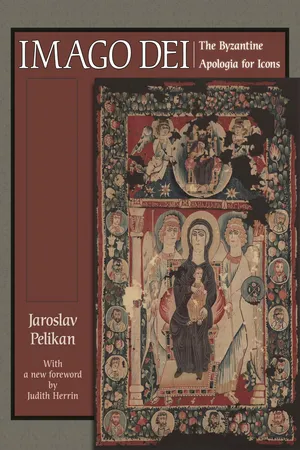
- 224 pages
- English
- PDF
- Available on iOS & Android
About this book
A sweeping account of the controversies surrounding the worship of images in the early Byzantine church
In 726, the Byzantine emperor, Leo III, issued an edict that all religious images in the empire were to be destroyed, a directive that was later endorsed by a synod of the church in 753 under his son, Constantine V. If the policy of Iconoclasm had succeeded, the entire history of Christian art—and of the Christian church, at least in the East—would have been altered.
Iconoclasm was defeated by Byzantine politics, popular revolts, monastic piety, and, most fundamentally of all, by theology, just as it had been theology that the opponents of images had used to justify their actions. Analyzing an intriguing chapter in the history of ideas, the renowned scholar Jaroslav Pelikan shows how a faith that began by attacking the worship of images ended first in permitting and then in commanding it.
Pelikan charts the theological defense of icons during the iconoclastic controversies of the eighth and ninth centuries, whose high point came in 787, when the Second Council of Nicaea restored the cult of images in the church. He demonstrates how the dogmas of the Trinity and the Incarnation eventually provided the basic rationale for images: because the invisible God had become human and therefore personally visible in Jesus Christ, it became permissible to make images of that Image. And because not only the human nature of Christ, but that of his Mother had been transformed by the Incarnation, she, too, could be "iconized," together with all the other saints and angels.
The iconographic "text" of the book is provided by one of the very few surviving icons from the period before Iconoclasm, the Egyptian tapestry Icon of the Virgin now in the Cleveland Museum of Art. Other icons serve to illustrate the theological argument, just as the theological argument serves to explain the icons.
In an incisive foreword, Judith Herrin explains the enduring importance of the book and discusses how later scholars have built on Pelikan's work.
Please note: All images in this ebook are presented in black and white and have been reduced in size.
Frequently asked questions
- Essential is ideal for learners and professionals who enjoy exploring a wide range of subjects. Access the Essential Library with 800,000+ trusted titles and best-sellers across business, personal growth, and the humanities. Includes unlimited reading time and Standard Read Aloud voice.
- Complete: Perfect for advanced learners and researchers needing full, unrestricted access. Unlock 1.4M+ books across hundreds of subjects, including academic and specialized titles. The Complete Plan also includes advanced features like Premium Read Aloud and Research Assistant.
Please note we cannot support devices running on iOS 13 and Android 7 or earlier. Learn more about using the app.
Information
Table of contents
- Cover
- Title
- Copyright
- Contents
- Dedication
- Foreword
- Preface
- Illustrations
- Abbreviations
- Introduction The Idea in the Image
- Chapter One: The Context Religion and “Realpolitik” Byzantine Style
- Chapter Two: Graven Images The Ambiguity of the Iconographic Tradition
- Chapter Three: Divinity Made Human Aesthetic Implications of the Incarnation
- Chapter Four: The Senses Sanctified The Rehabilitation of the Visual
- Chapter Five: Humanity Made Divine Mary the Mother of God
- Chapter Six: The Great Chain of Images A Cosmology of Icons
- Bibliography
- Index